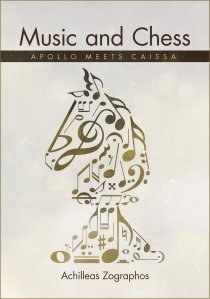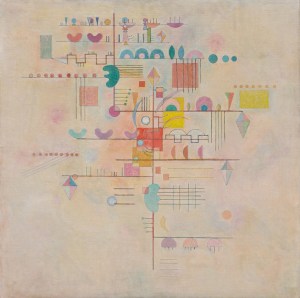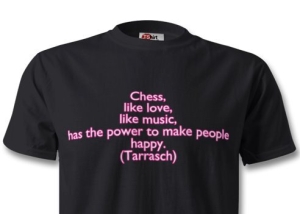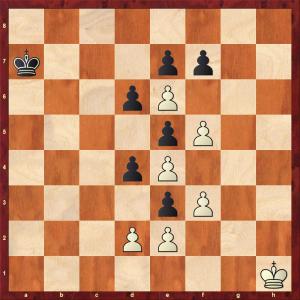 Music and Chess: Apollo meets Caissa. Achilleas Zographos. Milford, CT: Russell Enterprises, 2017. ISBN: 978-1-941270-72-1 (print); 978-1-941270-73-8 (ebook)
Music and Chess: Apollo meets Caissa. Achilleas Zographos. Milford, CT: Russell Enterprises, 2017. ISBN: 978-1-941270-72-1 (print); 978-1-941270-73-8 (ebook)
Books on chess are a curious genre. There are an awful lot of them, they are very hard to find in libraries. They nearly all fall into one of a few categories. Books on openings. Books on improving your chess technique. Collections of games (by an individual, or from a world title match, or from a significant tournament).
And that is about it. What all these books share as a quality is that they are absolutely incomprehensible to anyone who is not a keen chess player. I have many of them, and if I leave them lying around, members of my family ask me when I am going to read a “proper” book.
There are just two kinds of exceptions to this rule, and these exceptions contain my favourite kinds of chess book. The first is chess biography or autobiography: Korchnoi’s Chess is my life is worth reading as much for its picture of the privations of the siege of Leningrad as for its depiction of one of the most obdurate personalities ever to have graced the game. Emanuel Lasker: The life of a chess master (J. Hannak) is a riveting account of an extraordinary personality. But the second kind of exception to the normal run of chess literature is my favourite: books which take chess into other realms, such as literature or film (see my earlier post on Nabokov’s The Luzhin Defence), or the anecdotal and eccentric (by far my favourite is The Complete Chess Addict by Mike Fox and Richard James, and its enlarged version The Even More Complete Chess Addict). And now – joy of joys! – the chess publisher Russell Enterprises has presented a book on exactly the topic of this blog.
The first thing I want to say about this book is that you should definitely get yourself a copy, if you are reading this blog. I need to put that first, because I could hardly fail to welcome a publication such as this. Having said that, there are of course lots of things here which I would have put differently or with which I don’t quite agree. But these are the kinds of things one should discuss over a convivial drink, not reasons for disparaging the book.
Achilleas Zographos (since I contacted him, this blog has gained Greece as a new country in its stats profile) is a much better chess player than I am (he is a FIDE trainer) and also a much better performer (he is a concert pianist). There are times when his perspective is clearly that of a performer rather than a composer. But there are a lot of things I like about his book.
Things I like about this book
The author is clearly a man after my own heart, with a taste for the quirky and occasionally bizarre which I love. Perhaps all of us who love both chess and music as arts are similar in that way. He has compiled a huge quantity of anecdotes and information of the sort I find fascinating. Quite a lot of it I knew already (unsurprisingly); Fox & James (see above) are frequently cited as a source for anecdotes. But there is plenty in the book which I didn’t know: for instance, I didn’t know the sixteenth-century Italian poem which invented the dryad Schacchia, goddess of chess, and the eighteenth-century English poem in which she acquired the name Caïssa (the poems are described here); I had never come across Guido van der Werve’s chess piano (here is his concerto in three movements); and I did not know that GM Levon Aronian, who is about to compete in the 8-player knockout to determine the next World Title Candidate, has a passion for jazz.
The book is sumptuously illustrated. At the back are links for internet sources for the illustrations and YouTube videos. Sadly, some of these links seemed to be broken when I tried them; but I loved the quality of the illustrations reproduced. Trying to download one of the illustrations led me on an interesting detour. On p. 128 is printed a lovely canvas by Kandinsky, with the title Schach-Theorie [Chess Theory], and the date 1937. I did not know that Kandinsky (one of my favourite artists and a collaborator with the composer Arnold Schoenberg) had an interest in chess. When I found that the link at the back of the book seemed to be broken, I tried an internet search for the painting, and discovered that it has two quite different attributions. The canvas is owned by the Guggenheim Museum in New York, where it has the title Graceful Ascent and the date 1934.

I have to say that Graceful Ascent seems more convincing as a title, although there are some details near the top of the canvas that could conceivably be chess pieces.

So where do the probably false title and date come from? Further internet searching turned up what seems the likely source, and a wonderful anecdote. In 1937, the year that many of Kandinsky’s paintings were confiscated by the Nazis and displayed in the Exhibition of Degenerate Art, a retrospective of his work was displayed in the Swiss city of Bern. The city was home to another of the Bauhaus artists, Paul Klee, and the exhibition was to be the last time that the two artists met (Klee was seriously ill and died in 1940). According to the Bern artist Peter Matter, the two giants met in front of Kandinsky’s work Schach-Theorie, and both were seized by a sudden desire to go back to Klee’s house and play each other at chess. So perhaps the internet translation of Matter’s diary is the source of the misattribution. And perhaps it was a different canvas: both Klee and Kandinsky produced other works at that time that suggest the game of chess much more clearly to me (hover your mouse to see the titles).
So this is probably an error, as far as the content of the book goes; but I could hardly complain at that, since it sent me on a rewarding hunt which enabled me to place these two alongside Schoenberg as artists enthusiastic for the Royal Game.
Things I don’t like so much about this book
Most of the things I am less impressed with in the book are not the fault of its author. While the publisher should be applauded for commissioning this work, the author is not writing in his native language, and the services of a copy-editor would have improved it as a text to read. Infelicities such as “At the moment of writing” (rather than “At the time of writing”, p. 13); or grammatical lapses such as Steinitz’s “systematic, scientific approach of the game” (rather than “…approach to the game”, p. 21), are frequent and irritating. My annoyance at the blurb on the back cover engendered an earlier blog post, Prodigies: the preserve of music and chess? although I did discover on p. 39 that it was the American grandmaster Edward (not the World Champion Emanuel) Lasker who originally commented on child prodigies as a phenomenon of chess, music and mathematics.
Things that puzzle me in this book

There are a lot of lists in this book. That is no bad thing in itself; I like lists. The last chapter, ‘Quotations’ is in fact just a list of good quotations, which ought to delight designers of chess-related t-shirts.
Other lists are more intriguing. For instance, Beethoven appears in a long list of musicians who had a passion for chess on pp. 23–24; he is mentioned a dozen times elsewhere (the book has a good index), but always just as an emblem of “the great composer”; nowhere are we told the source for believing he had an interest in the game of chess. My scan through the several hefty volumes of his letters could find no mention of it at all; but I would love to know what evidence there is.
But lastly, the thing which puzzles me most about this book is actually the way that it compares the technical elements of chess and music. Several times, the author’s love for the quirky leads him to the most extraordinary chess compositions to illustrate the most ordinary elements of music. One is the study by Petrovic which is presented as an example of the role of rhythm and tempo in chess:

Another is the beautiful but totally bizarre study by van Reek which illustrates the musical idea of ‘texture’:

But the puzzlement I felt reading through the lengthy chapter entitled ‘Components’ which works its way through ‘Time, rhythm and tempo’, ‘Melody and movement’, ‘Harmony’, ‘Texture’, ‘Structure’, and ‘Timbre / colour’ turned from slight annoyance to perfect calm with the realisation that this most difficult of fields, making detailed and persuasive comparison of the technical aspects of the arts of chess and music, is left open to my own blog to attempt. Keep reading my posts here to see how well I get on with trying.



Don’t think I’d buy the t-shirt, but one with that Kandinsky painting on would be nice. It reminded me of the procedure diagrams I (try to) do at work for parts of the new CRM system. BTW, on the subject of homologous patterns of thinking (your earlier article), I’m reading a book called ‘Quantum Physics and Theology’ by John Polkinghorne. Fascinating to find similarities of form in subjects whose content has little to nothing in common. Here’s a quote: “I believe that a full understanding of this remarkable human capacity for scientific discovery ultimately requires the insight that our power in this respect is the gift of the universe’s Creator who, in that ancient and powerful phrase, has made humanity in the image of God.” Oh, and I enjoyed the back row mates with the Queen – so satisfying if one ever found oneself able to deploy one.
LikeLiked by 1 person
I knew John Polkinghorne’s son slightly at university. He’s a fascinating author.
LikeLike
Dear Robert,
Thank you very much for reviewing “Apollo meets Caissa”. You are one of the few who can write an objective review, since you are competent in both fields – music and chess. It is a pity that I was not aware of your blog. It goes without saying that in case a second edition of my book follows, your blog will be mentioned too.
Before proceeding, please let me inform you about the existence of the following book. In case you are not aware of it, I think you will love it:
https://www.amazon.com/Joys-Chess-Heroes-Battles-Brilliancies/dp/9056913557
Let’s turn back to our subject now. I must admit that your review is well-meaning. Thus, I fully respect your opinion. After reading many of your posts in your blog (I intend to read them all), I can only say that you have accomplished very interesting work.
However, there is a significant difference in our approach. When writing the book, my main concern was to do it in a way that it would be comprehensible for the average reader, not for the expert. Reading your articles was a great joy for me, however I doubt if a large number of even keen readers is able to follow (at least) some of your views without a certain degree of expertise on both fields.
You are right when complaining about some broken links. This is why I have included dates of retrieval for all internet sources. I have in the meantime created a link which should be of help. It contains all youtube videos suggested in the book with some updates (Index of videos). Here it is:
http://www.musicandchess.tk
I am not sure either about the probable error concerning Kandinsky’s canvas. You might be right on that as well. Same goes for Beethoven. However, I do give sources about him as for all other chess-playing musicians. Please read footnote 18, page 26.
As for your criticism on my language mistakes, I am afraid that I am not the one to judge. I did my best, not to mention that several native speakers went through the text several times. Russell Enterprises did a great job by helping me in every way possible. However, there is no doubt that the text of a book (especially when written by a non-native speaker) may always be improved.
As for the last part of the review, referring to the comparison of the technical elements of chess and music, I am afraid I do not understand your objections. I am not just offering the reader the chess examples you mention. Actually, I do compare them directly with music in a comprehensible manner.
It was delightful to read your review. How nice it would be to discuss these aesthetic issues over a convivial drink!
Regards, Achilleas
LikeLike
Achilles, thank you in turn for such a thoughtful and courteous reply! I very much hope that one day we will discuss our shared enthusiasms over that convivial drink I mentioned in the post.
LikeLike
If you are interested in the index of the videos and stumbled upon this comment, the page has been moved from http://www.musicandchess.tk to https://musicandchess.com .
LikeLike
Thanks, George!
LikeLike
Let’s hope so, I would like that very much too!
LikeLiked by 1 person
I had an independent idea recently that music theory may provide some much needed insights into my chess play so I simply googled chess and music and that is how I came upon your site. I’ve been seeing 3,4 and 5 piece combinations in my games that I sense as analogous to musical chords. I play both chess and have played woodwind music but have no music theory training and chords are a foreign to me. I am curious what you make of this idea. I suspect from reading some of your posts that this topic may be too musically elementary to you.
LikeLike
Glad you came across the blog! Yes, I think the pleasure you get from executing a chess combination is very similar to that you feel when you hear different musical lines combining as chords — I would tend to call that counterpoint rather than chords, but that’s because I AM a music theorist!
LikeLike